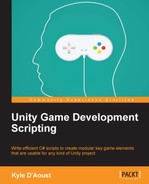This book will cover many helpful topics that you can utilize when you create your own games. As a game developer and scripter, you'll end up writing a lot of code that you would not want to write again; this book will help to solve that. You will learn how to make gameplay elements modular so that they can be used again in other projects as well. This book will take what you might already know about gameplay scripting in Unity to the next level.
Chapter 1, Interactive Input, gives an in-depth look at how to create controls for both the Xbox 360 Controller and mouse/keyboard inputs. Along with creating those inputs, you'll also create customizable control profiles that the player can use to play your game the way they want to.
Chapter 2, GUI Time, will help you create both 2D and 3D GUI elements. This covers health bars, player data, hovering 3D health bars, 3D damage reports, enemy names, and so on.
Chapter 3, Expandable Item Classes, will teach you how to create in-game item classes for self, melee, and projectile items. Then, you'll create a classification system for these items to determine what they do.
Chapter 4, Inventory, will teach you a way to create an inventory system for your game. In this system, there'll be common inventory elements created such as adding items, removing items, and creating quick-select items. Finally, you'll also create a way to show the inventory on the GUI.
Chapter 5, Enemy and Friendly AIs, will demonstrate how to create a dynamic AI. It will cover what a finite state machine is and also what a behavior tree is. This AI system will handle behaviors, actions, animations, pathfinding, and also a waypoint system.
Chapter 6, Keeping Score, covers how to create, track, and save stats for the player. You'll also create a system for achievements for those stats as well.
Chapter 7, Creating Save and Load Systems, covers how to create systems to save and load from a flat file as well as an XML file. Then, you'll take these systems and implement them on a checkpoint-based save system and an anywhere/anytime saving system.
Chapter 8, Aural Integration, covers the creation of systems that will handle background music, atmospheric sounds, and sound effects. These systems are a playlist system, a randomized system, and an event-driven system.
Chapter 9, Game Settings, covers how to create customizable configurations for audio and video settings. You'll create the ability to save and load these settings by using PlayerPrefs.
Chapter 10, Putting It All Together, will put almost everything you've learned from the previous chapters into a small game. By taking elements from the previous chapters, you'll create a short First Person Action RPG.
